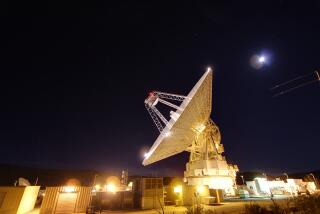Book Review : When Space Program Lost Its Luster
- Share via
Prescription for Disaster: From the Glory Days of Apollo to the Betrayal of the Shuttle by Joseph J. Trento with reporting and editing by Susan B. Trento (Crown: $18.95)
Challenger: A Major Malfunction by Malcolm McConnell (Doubleday: $17.95)
A few months ago, James Fletcher, the former and current administrator of the National Aeronautics and Space Administration, spent part of an afternoon at The Times, answering questions and assuring us that all is well at the space agency, that the lessons of Challenger have been learned and implemented and that the disaster is behind them.
Fletcher would have a hard time persuading the authors of “Prescription for Disaster” and “Challenger: A Major Malfunction,” the first two books on the space shuttle and NASA since the accident 14 months ago. They paint a story of idealism turned to greed, a noble venture gone sour, an accident made inevitable by politics. These problems are not easily repaired.
Much has been written about the space program in the last year, and the failings of the space agency have become so familiar that it is hard to imagine there is much left to be said. In fact, the authors of both “Prescription for Disaster” and “Challenger: A Major Malfunction” have done very good jobs putting the story together and giving it enough new material and analysis to make their books worthwhile.
“Prescription for Disaster” by Joseph J. Trento with reporting and editing by Susan B. Trento is the broader of the two. In 295 pages, it sweeps through the political history of the space program from Sputnik to the shuttle. The Trentos (he’s with Cable News Network in Washington, and she works on Capitol Hill) have a firm grip on their material, which is laced with telling anecdotes that advance the story.
President Kennedy embraced the space program for the best reasons. He also knew its tremendous real and propaganda importance for the Cold War. There was, after all, a space race. He also knew that politically it was a very popular program at home. Small wonder that he set the nation on its course to the moon.
When Lyndon Johnson was majority leader of the Senate, he was an enthusiastic supporter of the space program, and he continued that support when he was vice president. But as President, Johnson’s attention was diverted by the Vietnam War, and he lost interest.
Richard Nixon had no interest in space to begin with, and the fact that NASA was Kennedy’s baby made him all the more hostile. The Nixon Administration left a Democrat, Thomas O. Paine, as administrator of NASA because they didn’t want to risk sullying a Republican with the failure of the moon program, which they expected.
Nixon came around when he discovered the public’s great enthusiasm for the space program and its attendant political benefit, and, ironically, his name is on the plaque that the first lunar astronauts left on the moon.
But Nixon’s heart was never in it, the Trentos say. The idealism and uncompromising standards of the Kennedy NASA were giving way to business as usual. Visionaries were replaced by bean counters, which is always the way, isn’t it?
Key appointments were made on the basis of politics, not merit. Budgets were cut. Program initiatives were delayed. For the first time, money became a problem for NASA. All the while, the seeds were being sown for the Challenger explosion and loss of seven lives.
Steely and Harsh
The Trentos’ indictment of NASA is steely and harsh. It also enjoys the advantage of hindsight. Given the political and financial realities, almost every decision was justifiable at the time. It is understandable that NASA made the mistake of believing its own publicity. Until Challenger, it had a phenomenal record of success. It is understandable that the agency became complacent and lowered its guard.
Malcolm McConnell’s “Challenger: A Major Malfunction” covers much of the same material that the Trentos’ book does. But it gives short shrift to the history and emphasizes the Challenger accident itself, including a moment-by-moment re-creation of the weeks, days, hours and minutes leading up the disaster, which would be tedious were it not for McConnell’s breezy style.
Like the Trentos’ book, McConnell’s is also a history of saving money and of decision-making based on politics.
Here, too, it is hard to lay the blame anywhere but on the system--whatever that means. It is certainly true that people tend to act in their own self-interest, and venality is part of the history of the shuttle. But self-interest and public interest can coincide, and they often do, which is why capitalism and democracy work at all.
There have been many mistakes in the U.S. space program over the last 20 years, and both of these books cite them chapter and verse. It comes down to this: NASA didn’t get the money it needed to continue its bold exploration of the solar system and the universe. Once the Apollo program was over, space lost its luster, and NASA had to make do on less. That was a political decision, and everything followed from it.
But who is at fault? And, more important, have sufficient changes been made, as Fletcher, the NASA administrator, insists they have been? Can such changes be made?
More to Read
Sign up for our Book Club newsletter
Get the latest news, events and more from the Los Angeles Times Book Club, and help us get L.A. reading and talking.
You may occasionally receive promotional content from the Los Angeles Times.









